1993 CADILLAC FLEETWOOD check transmission fluid
[x] Cancel search: check transmission fluidPage 213 of 386
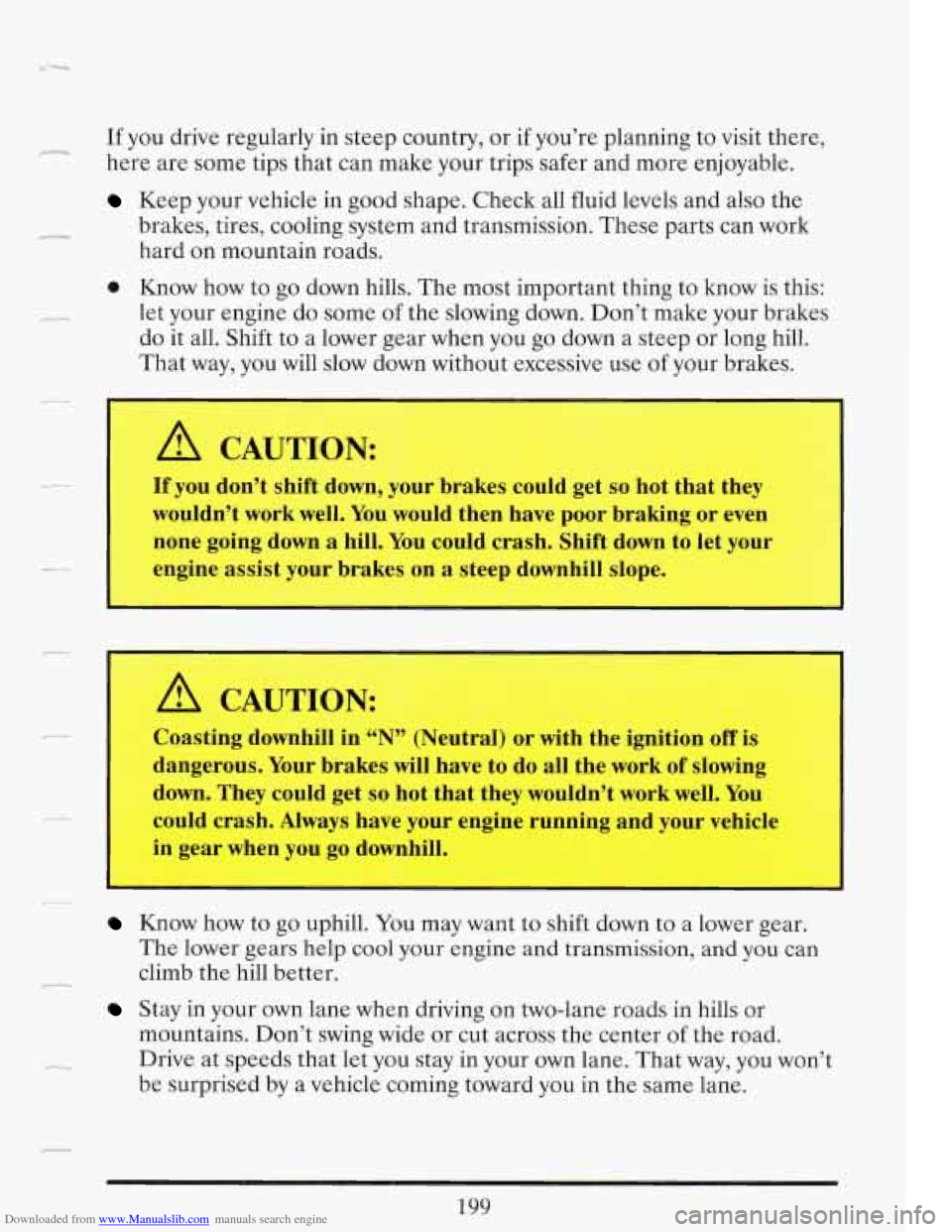
Downloaded from www.Manualslib.com manuals search engine c If you drive regularly in steep country, or if you’re planning to visit there,
here are some tips that can make your trips safer and more enjoyable.
Keep your vehicle in good shape. Check all fluid levels and also the
brakes, tires, cooling system and transmission. These parts can work
hard on mountain roads.
0 Know how to go down hills. The most important thing to know is this:
let your engine do some
of the slowing down. Don’t make your brakes
do it all. Shift to a lower gear when you go down a steep or long hill.
That way, you will slow down without excessive use
of your brakes.
I_ I
I
I A CAUTION:
If you don’t shift down, your brakes could get so hot that they
wouldn’t work well. You would then have poor braking or even
none going down a hill. You could crash. Shift down to let your
engine assist your brakes on
a steep downhill slope.
I
A CAUTION:
- I Coasting downhill in “N” (Neutral) or with the ignition off is
dangerous. Your brakes
will have to do all the work of slowing
down. They could get
so hot that they wouldn’t work well. You
could crash. Always have your engine running and your vehicle
in gear when you go downhill.
I
Know how to go uphill. You may want to shift down to a lower gear.
The lower gears help cool your engine and transmission, and you can
e.-- climb the hill better.
,-
Stay in your own lane when driving on two-lane roads in hills or
mountains. Don’t swing wide or cut across the center of the road.
Drive at speeds that let you stay in your own lane. That way, you won’t
be surprised by a vehicle coming toward you in the same lane.
Page 229 of 386
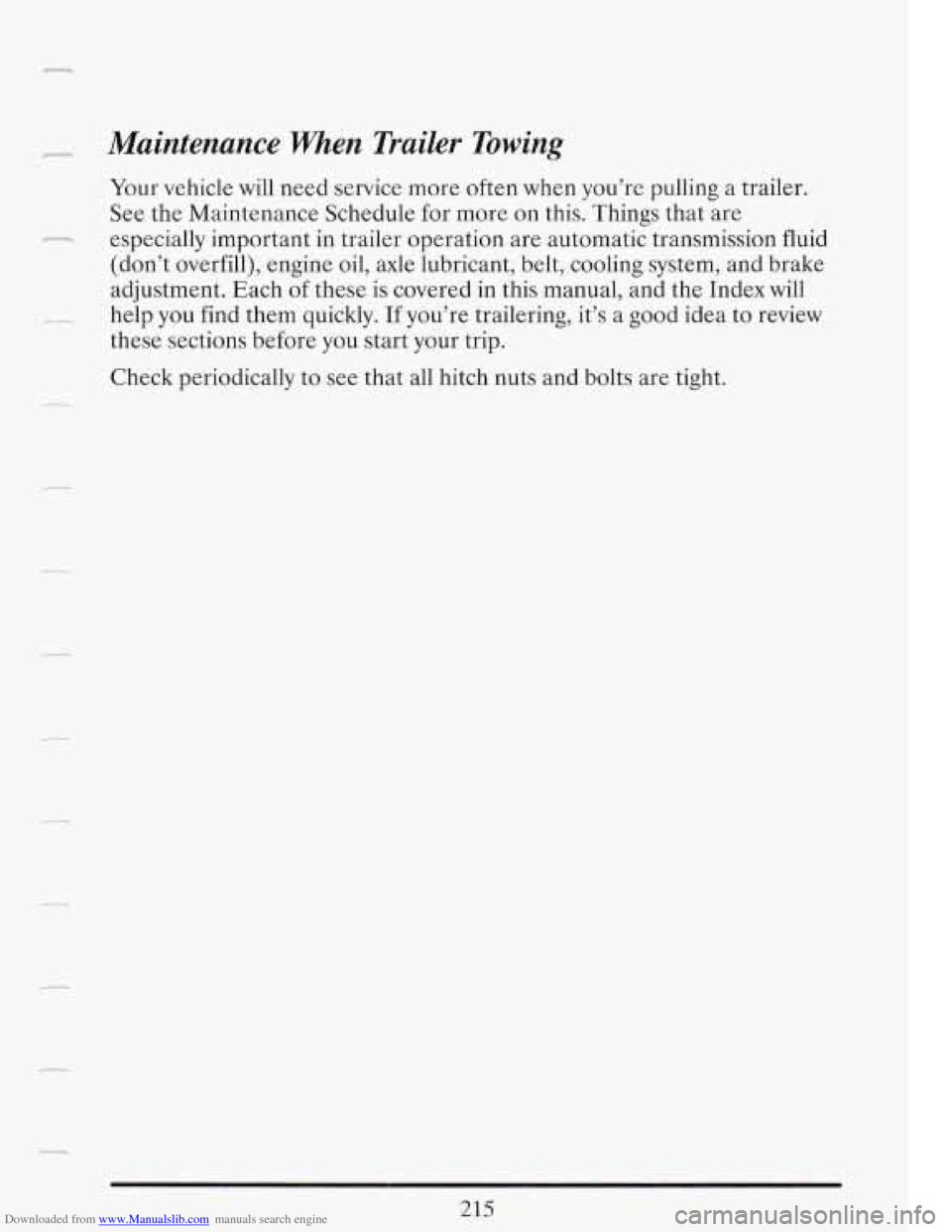
Downloaded from www.Manualslib.com manuals search engine - Maintenance when Trailer Towing
Your vehicle will need service more often when you’re pulling a trailer.
See the Maintenance Schedule for more on this. Things that are
(don’t overfill), engine oil, axle lubricant, belt, cooling system, and brake
adjustment. Each
of these is covered in this manual, and the Index will
__- help you find them quickly. If you’re trailering, it’s a good idea to review
these sections before you start your trip.
Check periodically to see that all hitch nuts and bolts are tight.
rc-.- especially important in trailer operation are automatic transmission fluid
215
Page 280 of 386
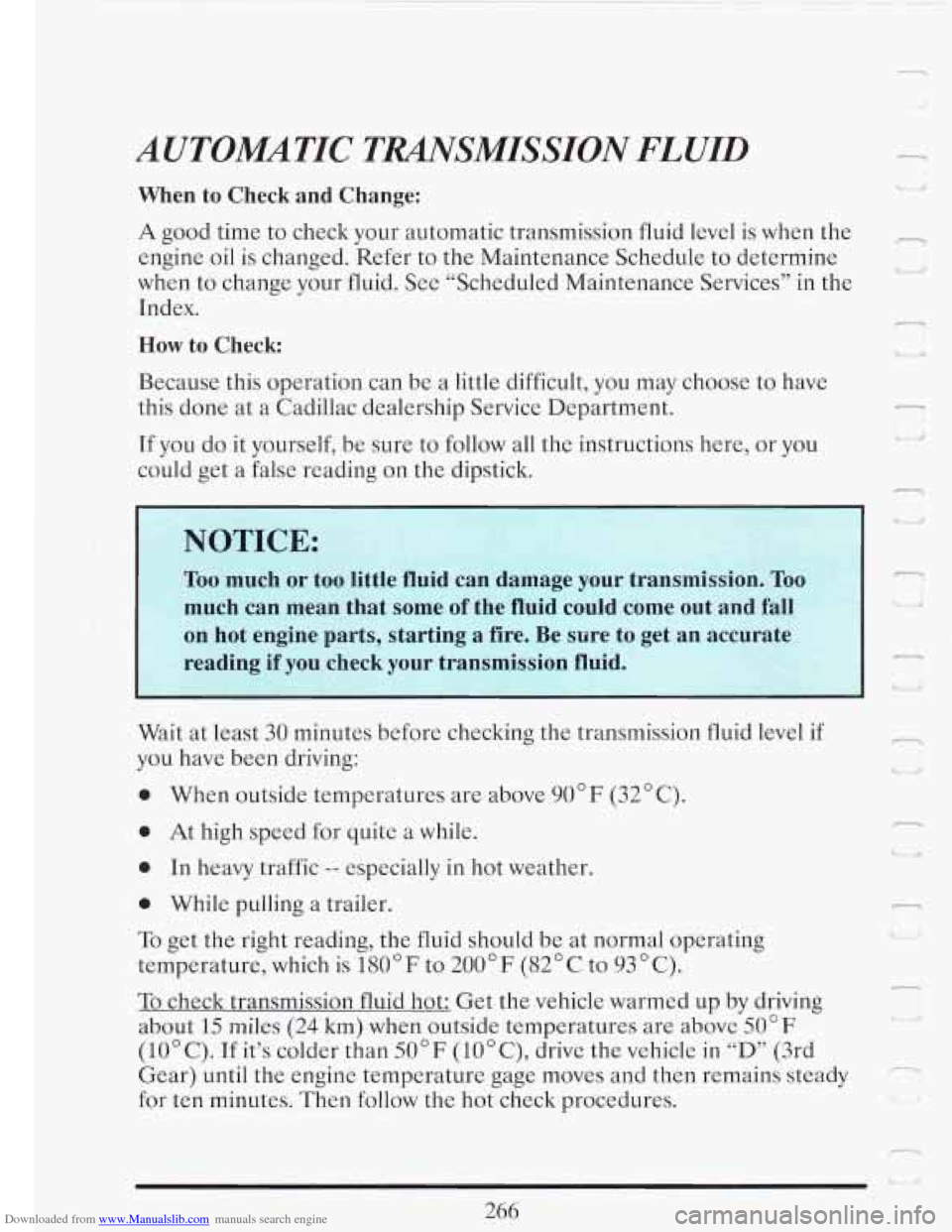
Downloaded from www.Manualslib.com manuals search engine AUTOMATIC TMSMISSION FLUID
When to Check and Change:
A good time to check your automatic transmission fluid level is when the
engine oil is changed. Refer to the Maintenance Schedule to determine
cpr
when to change your fluid. See “Scheduled Maintenance Services’’ in the
Index. -I
How to Check
BeC’%’uSe this operation can be a little difficult, you may choose to have
this done at a Cadillac dealership Service Department.
r IYI
”I If you do it yourself, be sure to follow all the instructions here, or you
could get a false reading on the dipstick.
p_
NOTICE:
I
Too much or too little fluid can damage your transmission.
much can mean that some of the fluid could come out and fall
on hot engine parts, starting
a fire. Be sure to get an accurate
reading if you check
your transmission fluid. I
l-
Wait at least 30 minutes before checking the transmission fluid level if
you have been driving:
0 When outside temperatures are above 90” F (32” C).
n !‘ b
0 At high speed for quite a while.
0 In heavy traffic -- especially in hot weather.
0 While pulling a trailer.
To get the right reading, the fluid should be at normal operating
temperature, which is
180°F to 200°F (82°C to 93OC).
To check transmission fluid hot: Get the vehicle warmed up by driving
about
15 miles (24 km) when outside temperatures are above 50°F
(10°C). If it’s colder than 50°F (lO°C), drive the vehicle in “D” (3rd
Gear) until the engine temperature gage moves and then remains steady
-
for ten minutes. Then follow the hot check procedures. t3
_L-
1 <- 1
266
Page 281 of 386
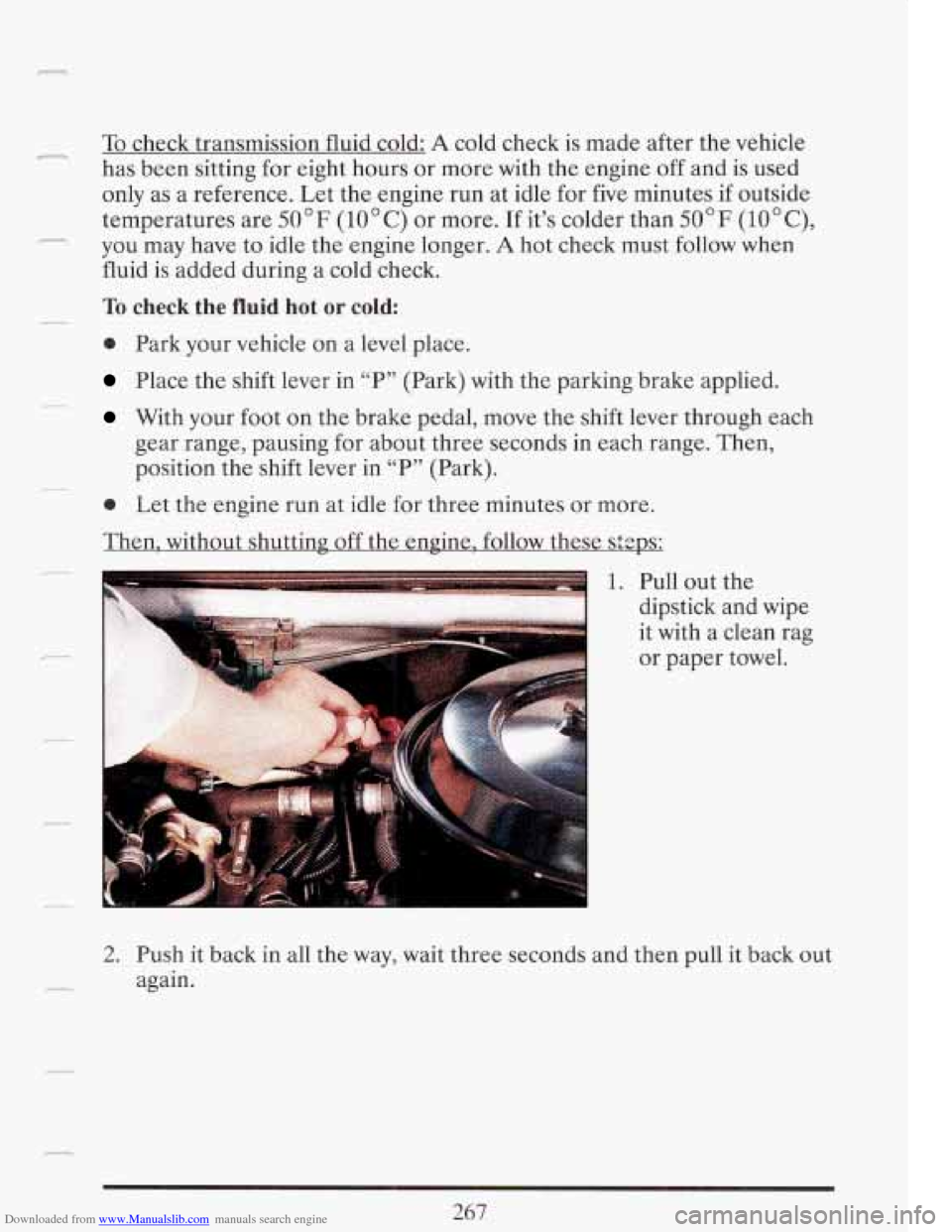
Downloaded from www.Manualslib.com manuals search engine n To check transmission fluid cold: A cold check is made afte.r the vehicle
has been sitting for eight hours or more with the engine off and is used
only as a reference. Let the engine run at idle for five minutes if outside
temperatures are
50°F (10°C) or more. If it’s colder than 50°F (lO°C),
you may have to idle the engine longer. A hot check must follow when
fluid is added during a cold check. .-
To check the fluid hot or cold:
0 Park your vehicle on a level place.
Place the shift lever in “P” (Park) with the parking brake applied.
__
With your foot on the brake pedal, move the shift lever through each
gear range, pausing for about three seconds in each range. Then,
position the shift lever in
“P” (Park). ~
0 Let the engine run at idle for three minutes or more.
Then. without shutting
off the engine! follow these skgs:
2. Push it back in all the way, wait three seconds and then pull it back out
again.
267
Page 282 of 386
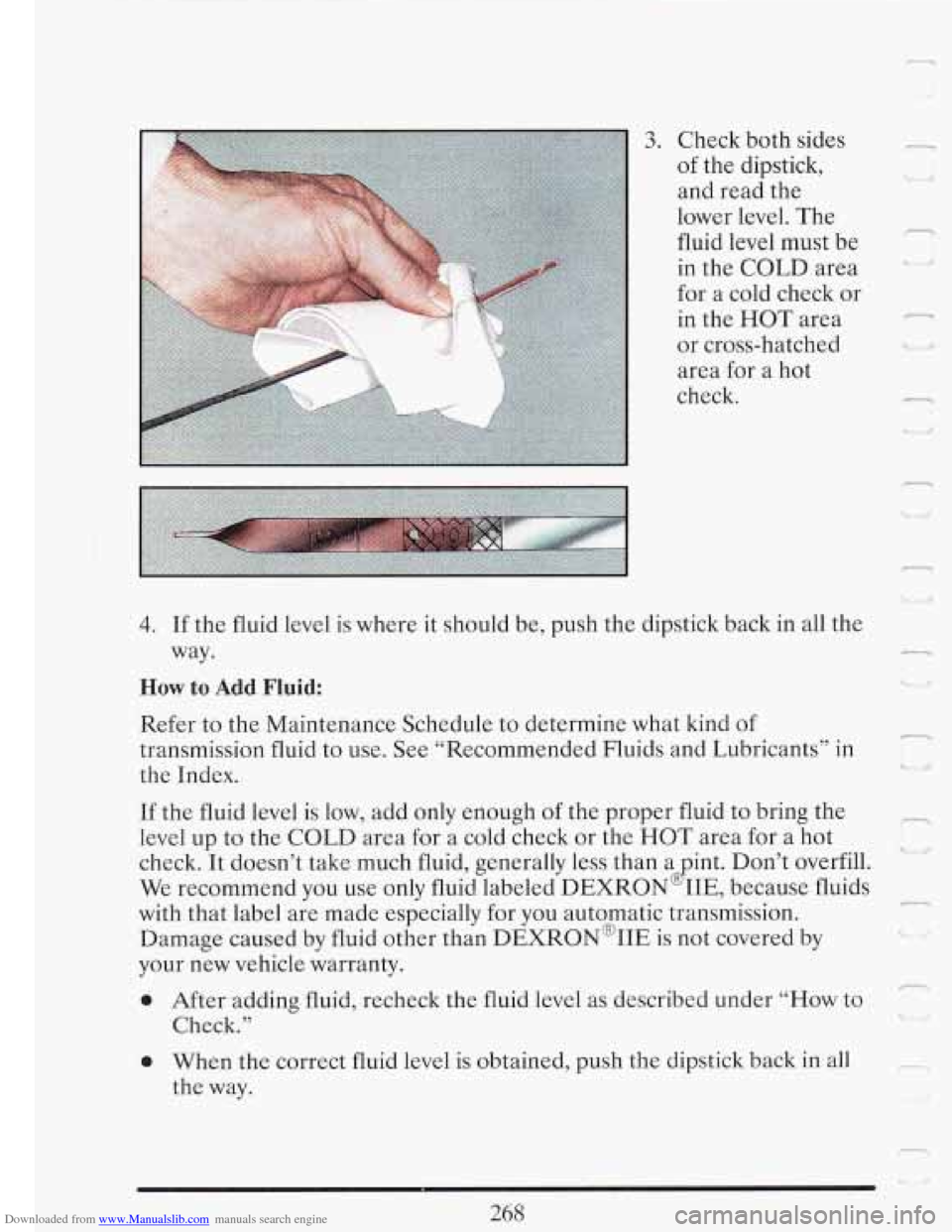
Downloaded from www.Manualslib.com manuals search engine 3. Check both sides
of the dipstick,
and read the
lower level. The
fluid level must be
in the COLD area
for a cold check or
in the HOT area
or cross-hatched area for a hot
check.
r
i4
I’
n i; U
4. If the fluid level is where it should be, push the dipstick back in all the
way.
How to Add Fluid:
Refer to the Maintenance Schedule to determine what kind of
transmission fluid to use. See “Recommended Fluids and Lubricants” in
the Index.
If the fluid level is low, add only enough of the proper fluid to bring the
level
up to the COLD area for a cold check or the HOT area for a hot
check. It doesn’t take much fluid, generally less than a
int. Don’t overfill.
We recommend you use only fluid labeled
DEXRON IIE, because fluids
with that label are made especially for you automatic transmission.
Damage caused
by fluid other than DEXRON@IIE is not covered by
your new vehicle warranty.
8
0 After adding fluid, recheck the fluid level as described under “How to
Check.”
0 When the correct fluid level is obtained, push the dipstick back in all
the way.
n I L> Y
r
Ll
I
r.
- I ‘1
Page 369 of 386

Downloaded from www.Manualslib.com manuals search engine In
Cables. B
Camper. Towing A
.................................. 208
Capacities. Fluid ................................... 324
C& Jack I&tructions ............................... 237
Carbon Monoxide In Exhaust ...................... 93. 207
Cassette Tape Player. Care Of Your ................... 155
Cassette Tape Systems .............................. 150
Cautions. Safety ...................................... 1
CB Radio. Adding A ............................. 143. 312
Cellular lklephone. Adding A ..................... 143. 312
Center High Mounted Stop Lamp Bulb Replacement .... 287
Chains. Tire ....................................... 300
Change Oil Light ................................... 131
Changing A Flat Tire ............................... 237
Chassis Lubrication ................. See Maint . Book. p.15
checking
Service Station
................... See Maint . Book, p.8
The Power Steering Fluid ......................... 273
Central Door Unlocking Feature ....................... 67
Change The Oil. When To ........................... 263
Charge Light ...................................... 130
The Brake Fluid ................................. 276
The Engine Oil Level ............................ 259
The Transmission Fluid ........................... 266
Things Under The Hood ........................... 257
Your Restraint Systems ............................ 61
Your Safety Belt Systems ........................... 61
Che&al Paint Spotting ............................. 309
Child Restraint. Securing ............................. 48
Child Restraints ..................................... 43
Cigarette Lighter ................................... 120
Circuit Breakers ................................... 313
City Driving ....................................... 193
Cleaner. Air ....................................... 265
Cleaning
Fabric
....................................... 303. 304
Glass .......................................... 306
Leather And Vinyl ............................... 305
Photocells ...................................... 116
SafetyBel ts ..................................... 306
The Inside Of Your Cadillac ....................... 302
The Outside Of Your Cadillac ..................... 307
The Power Antenna .............................. 155
The Top of the Instrument Panel ................... 305
The Underbody Of Your Car ...................... 309